Hockey drills
Two teams with substitutes, substitutions are made when a goal is scored.
Each person defends a goal, on each field there are 5 goals, so there are also 5 people who defend these goals.
If a goal is scored in your goal, you have to sit on the sidelines and you are changed. A new player (substitute) from the side enters the field and will defend the goal.
If a goal is scored, it is 1 point. The team with the most points at the end of the game is the winner.
Variation:
First 1 ball, then several balls in the field.
The pass to the right goes diagonally forward and over the backhand side of the defender, the pass to the left you play wide and goes over the forehand side of the defender.
Therefore the pass to the right is preferred over the pass to the left.
- This is a basic exercise in preparation.
- Just like a tennis player who prepares for training with basic strokes, the players must prepare for the complex training and competition forms, with direct simple passes on top of each other.
- In this way, the trainer has the ability to see technical errors in each individual player and correct them as early as the basic exercise.
- The players pass the ball directly between two pylons and walk counter-clockwise to the other side.
- The size of the target and the distance between the players will be adjusted according to the age and level of the players.
- 1A person on the 23 meters,
- 1B on the back line.
- Both on the left side of the field.
- A scoops to B and runs to head circle.
- B runs to circle edge and plays on A.
- A finishes on goal.
- Blue player receives the ball from the white player each time. (white player distributed)
- Red player runs from stroke point to head circle and receives ball from blue player.
- Red player shoots on goal.
- After each shot he walks back to stroke point and then receives the next ball from head circle.
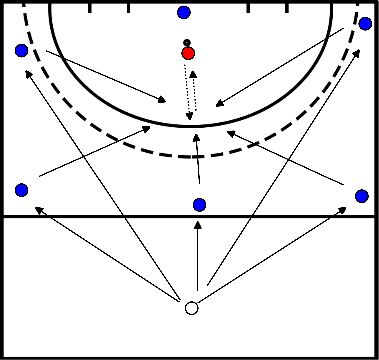
- Players outside the box should replay as often as possible.
- The pass must always pass through the box.
- The players inside the box must try to intercept the ball.
- As soon as the players inside the box have intercepted the ball, they should replay as often as possible inside the box.
- Each time they have replayed 3 times, someone outside the box may enter the box to recapture the ball.
- As soon as they succeed, they will play to someone outside the box and it will start over again, so at least one player must always remain outside the box to be able to play.
- The field can be larger or smaller, there can be more or less players inside and outside the box.
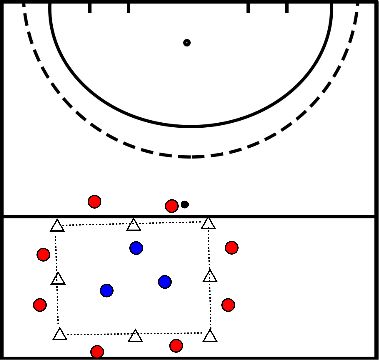
- Player 1 runs with the ball to the white pilon, player 2 runs without the ball to the white pilon.
- Player 2 rounds off on goal (with backhand).
- Player 1 runs around the pilon where player 2 started and runs to the center of the circle.
- As soon as player 1 has played the ball to player 2, player 3 may start. Player 3 plays the ball to player 4.
- Player 4 runs around the white pilon and plays the ball (with backhand) to player 1 who has run into the circle.
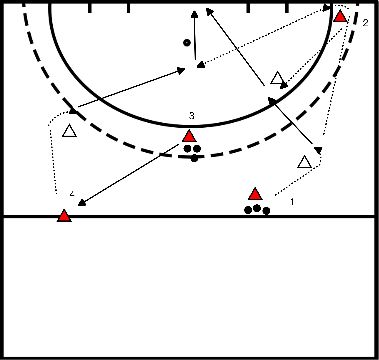
Make 2 teams.
- Both teams have their 'own' course, where they can score points (for example by playing over 5 times in their own course).
- The other team is allowed to conquer the ball in the other box, but not everyone from the other team is allowed to enter the other box.
- The number of players of the other team -1.
- As soon as blue has captured the ball, blue will go to his own square as soon as possible and will play over there as often as possible.
- There may be 3 players of red in the blue box.
- See example: in team red there are 4 players, so 3 players of blue are allowed to enter the red box.
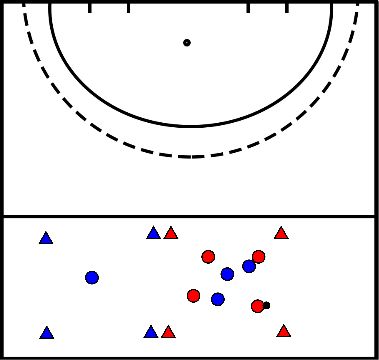
- Goal: to show the player when it is best to pass and when it is best to push.
- In case of a long pass you pass, in case of a short pass you push.
- Player 1 passes (long pass) the ball to player 2
- Player 2 pushes (short pass) the ball to player 3.
- Player 3 passes (long pass) the ball to player 4.
- Player 4 pushes (short pass) the ball to player 5.
- Player 5 passes (long pass) the ball to player 6.
- Player 6 pushes (short pass) the ball to player 7.
- Player 7 runs along the red pilons to the back line and passes (long pass) the ball to player 8, who has entered the circle.
- When explaining the exercise, you can let the player fill in whether it's a long or short pass and what kind of stroke you use, this way they will actively think about it and will apply it earlier in the game.
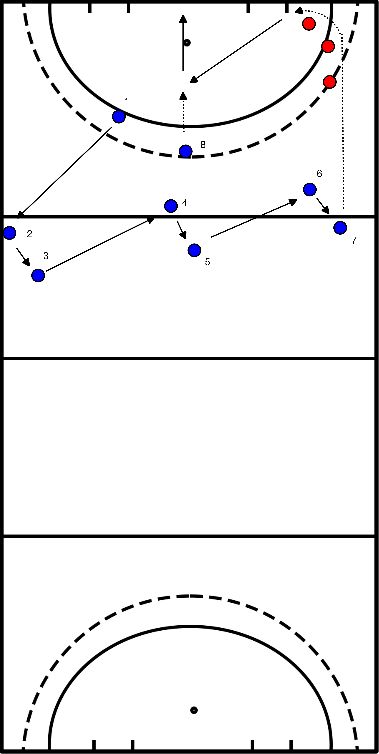
- Make 2 teams.
- From each team place 2 players outside the box opposite each other.
- The ball starts with one of the players outside the box (in the example red).
- As a team you get a point to play from one side to the other, through the players in the box.
- Make the box smaller to make it more difficult or with fewer players.
- Make the box larger to make it easier or with more players.

- We run as a team from one sideline to the other which is on the other side.
- When we get there we jog back as a team and then jog up and down again.
- We divide the group into two equal groups.
- So that we can perform the warm-up a bit faster
- We jog to the first pilon there you run backwards back to your starting position.
- Then you jog to the second pilon, when you get there you go back to the first pilon.
- Until you reach the end of the jog you go back to the first pilon twice.
- Knee lift to the pilon
- heels to buttocks to the next pilon
- Then lift knee again
- The last one is again heel to buttocks 2x
- You start waving your arm forward to the end of the line, back with your right arm.
- Now you're going to swing two arms forward to the end of the line, back with your arms backwards.
- We jog to the second pilon from there and accelerate with a sideways pass to the pilon on your left or right.
- Once there you accelerate again with a forward motion to the pilon in front of you. 2x
- The last one is that we will sprint, you jump 3 times in the light and then perform a constructive sprint to the center of the field or the indicated pilon. 2x
- After this we take a short time to stretch the muscles.

- Player 1 adapts player 2 in the loop.
- Player 2 passes the 3 pilons. On the 4th pilon, the player passes on the left and player 3 passes in the loop.
- Player 3 accompanies the ball and passes it to player 2, who has moved on to the header circle.
- Player 2 completes the round with the backhand on goal.
- Make sure player 2 at the last pilon holds the ball on the forehand and passes.









